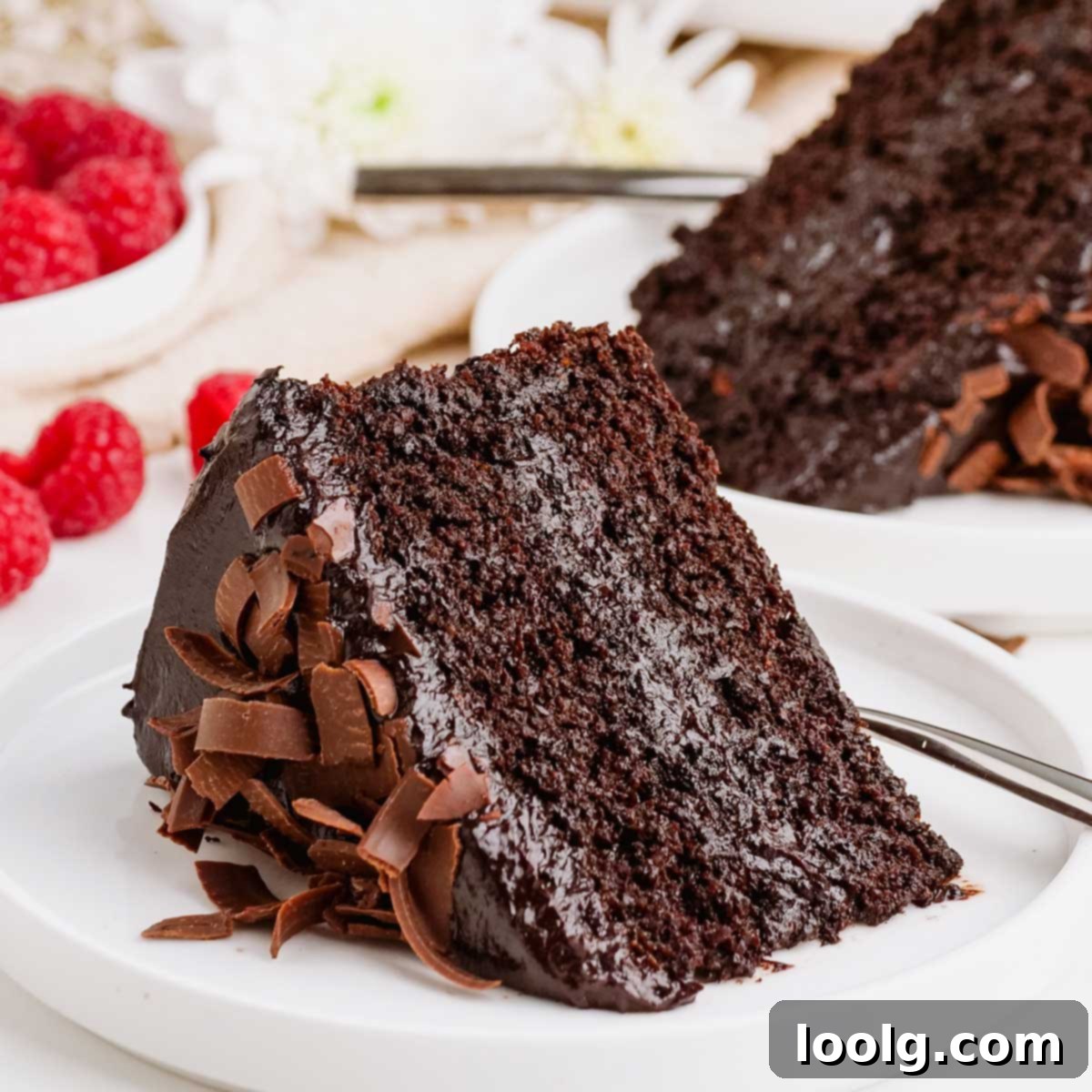Ultimate Healthy Chocolate Cake Recipe: Deliciously Moist & Versatile (Gluten-Free & Vegan Options!)
Prepare to be amazed by this incredibly moist and intensely chocolaty healthy chocolate cake. It redefines guilt-free indulgence, offering a dessert that’s not only delicious but also thoughtfully crafted with wholesome ingredients. We make it healthier by using nourishing whole wheat flour and natural sweeteners like honey or coconut sugar. The best part? This versatile recipe effortlessly adapts to various dietary needs, easily made both gluten-free and vegan, ensuring everyone can enjoy a slice of pure bliss.
Unlike traditional chocolate cakes laden with refined sugars and all-purpose flour, our recipe strikes a perfect balance between health and flavor. By opting for whole grains and natural sweeteners, we significantly boost its nutritional profile without compromising on that decadent taste you crave. In fact, many find this healthier version to be every bit as satisfying and delicious as the finest chocolate cakes they’ve ever had. Get ready to enjoy a treat that truly satisfies your sweet tooth while aligning with a healthier lifestyle!
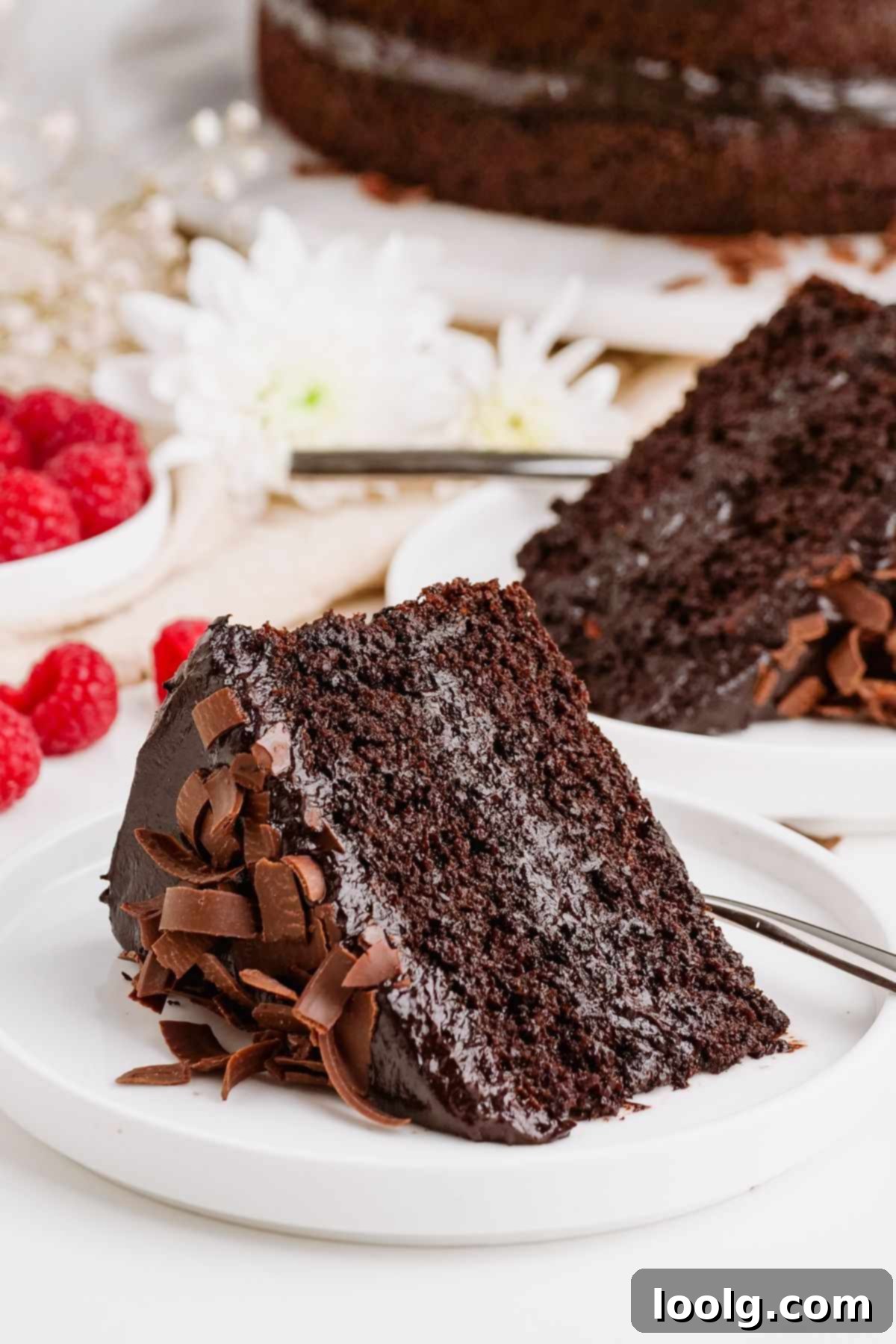
Embracing Healthier Baking: Traditional vs. Wholesome Chocolate Cake
When it comes to baking a chocolate cake, you typically face a choice: stick to a classic, often indulgent recipe, or explore healthier alternatives. With this particular recipe, you truly get the best of both worlds. You can craft a cake that tastes indistinguishable from its traditional counterpart, yet boasts a much healthier nutritional profile. Why settle for anything less when you can achieve incredible flavor and texture while maximizing the health benefits?
This recipe is designed to empower you with choices, allowing you to tailor your cake to your specific dietary preferences or health goals. Whether you’re looking to reduce refined sugar, increase fiber, or accommodate gluten-free or vegan diets, this healthy chocolate cake offers a pathway to deliciousness without compromise. It’s a testament to the fact that “healthy” doesn’t have to mean sacrificing taste or enjoyment.
Customizing Your Healthy Chocolate Cake: Ingredient Options
One of the standout features of this recipe is its incredible flexibility. You have a range of choices for key ingredients, each allowing you to adjust the cake’s health profile and cater to different dietary requirements. This adaptability ensures that everyone, regardless of their specific needs, can enjoy a delectable slice of this rich chocolate cake.
- Flour: Choose between regular all-purpose flour for a classic texture, or elevate the nutritional value with whole wheat flour, white whole wheat flour, or whole spelt flour. For those with gluten sensitivities, a high-quality gluten-free flour blend works beautifully.
- Eggs: Opt for traditional large eggs for richness and structure, or easily convert the recipe to be egg-free and vegan by using chia eggs.
- Sweetener: Sweeten your cake with conventional granulated sugar, or choose healthier alternatives like coconut sugar or honey. Each offers a unique flavor and sweetness level.
- Oil: Any neutral-tasting oil will work, allowing you to select based on preference or availability.
Throughout this recipe, I’ve provided numerous options for flour, sweetener, and eggs. While each version yields a delicious cake, you might notice a subtle difference in sweetness and texture between a cake made with 1 cup of honey versus one made with 2 cups of granulated or coconut sugar. The honey version, for instance, will naturally be less sweet than those made with a higher quantity of granulated sugars. However, once topped with a luscious frosting, even the honey-sweetened cake achieves a perfectly balanced sweetness that most find utterly satisfying!
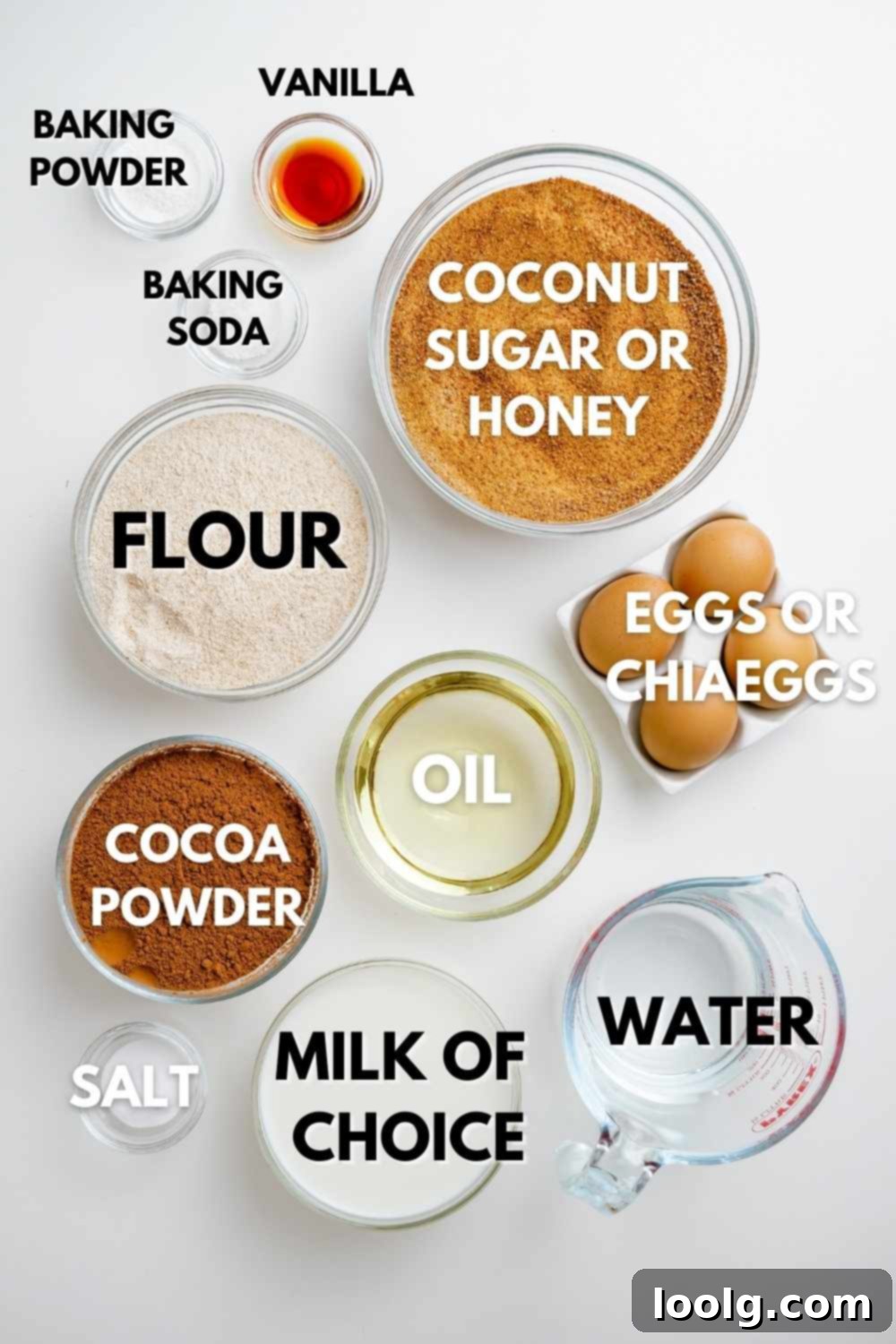
Delving Deeper into Ingredient Choices
The beauty of this healthy chocolate cake lies in its thoughtful ingredient substitutions, allowing you to enjoy a treat that feels indulgent without the usual guilt. Let’s explore why these healthier choices make a significant difference:
Flour: The Foundation of Your Cake
- Whole Wheat Flour, White Whole Wheat Flour, or Whole Spelt Flour: These options significantly increase the fiber content of your cake compared to traditional all-purpose flour. Fiber is essential for digestive health and can help regulate blood sugar levels. Whole spelt flour offers a slightly nuttier flavor and a lighter texture than regular whole wheat, while white whole wheat provides the benefits of whole grains with a milder taste and finer texture, making it an excellent bridge for those new to whole grain baking. All these flours impart a wonderful depth of flavor without making the cake dense or “cardboardy,” thanks to the rich cocoa and oil content.
- All-Purpose Flour: If you prefer a more traditional cake texture or are simply not concerned with the whole grain aspect, all-purpose flour is a perfectly acceptable choice that will still yield a fantastic result.
- Gluten-Free Flour Mix: For a truly gluten-free experience, a 1-to-1 gluten-free baking mix is crucial. I’ve had great success with Bob’s Red Mill 1-to-1 Gluten-Free Baking Flour. Another excellent option is King Arthur Flour Gluten-free Measure for Measure Flour. While it performs well, cakes made with King Arthur’s blend might be a touch more fragile, which isn’t an issue unless you plan on intricate carving. It’s important to use a reliable 1:1 blend designed for substitution, as other single gluten-free flours (like almond or coconut flour) require entirely different liquid ratios and structures, and won’t work in this recipe without significant modification.
Sweeteners: Natural Goodness
- Honey or Coconut Sugar: These natural sweeteners offer a delightful flavor profile and are often preferred over refined granulated sugar. Honey provides a unique floral note and helps create an incredibly moist cake. Coconut sugar, derived from the sap of coconut palm, has a caramel-like flavor similar to brown sugar and a lower glycemic index than regular sugar. Both are excellent choices for reducing the overall refined sugar content.
- Granulated Sugar: For a familiar sweetness and texture, regular granulated sugar can certainly be used. This recipe accommodates it seamlessly if that’s your preference.
Eggs: Binding and Lifting
- Large Eggs: Standard large eggs provide essential structure, moisture, and richness to the cake.
- Chia Eggs (for Vegan/Egg-Free): For a vegan or egg-free version, chia eggs are a fantastic substitute. Simply mix 2 tablespoons of ground chia seeds with 6 tablespoons of water and let it sit for a minute or two until it forms a goopy, egg-like consistency. This natural binder works surprisingly well in cakes, contributing to a moist crumb without any noticeable flavor difference.
Oil: The Secret to Moisture
The type of oil you choose plays a significant role in the cake’s texture. Any neutral-tasting oil will work effectively in this recipe. Options include light olive oil, canola oil, vegetable oil, or grapeseed oil. These oils are 100% fat, contributing significantly more moisture than butter (which contains water solids). If you opt for unrefined coconut oil, be aware that you might detect a subtle coconut flavor in the final cake. For a completely neutral taste, refined coconut oil is recommended, and it should be melted before incorporating into the batter. If using olive oil, even extra-virgin, any strong flavor tends to dissipate once the cake has cooled completely.
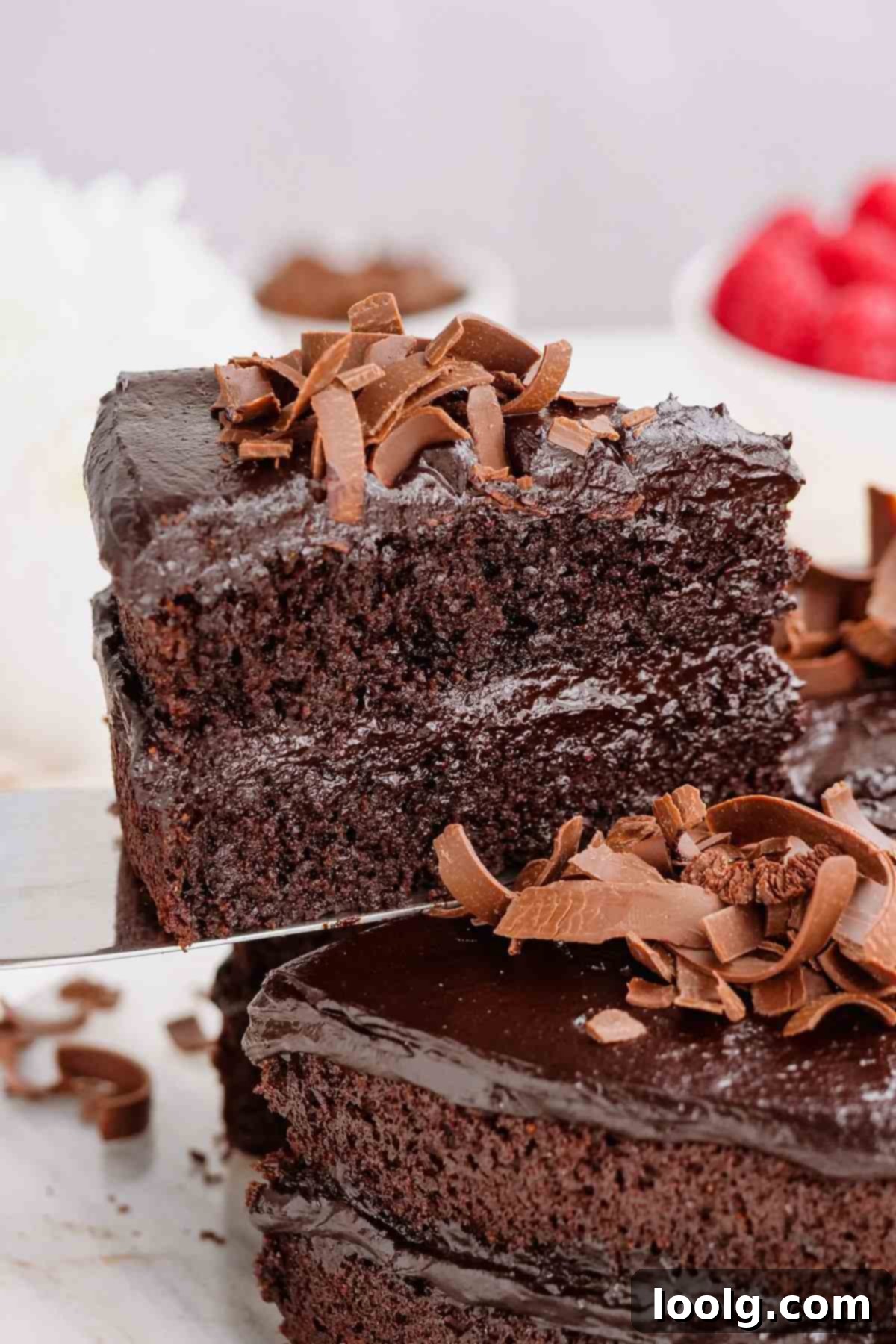
Baking Times: A Gentle Reminder
It’s crucial to note that baking times can vary quite a bit depending on the specific combination of flour, sweetener, and egg substitutes you choose. Honey, for example, bakes quicker than granulated sugar, necessitating a slightly lower oven temperature. Similarly, gluten-free flours or chia eggs might behave differently than their traditional counterparts. Always keep a close eye on your cake, and rely on the toothpick test: when a toothpick inserted into the center comes out with moist crumbs (but no wet batter), your cake is ready. This attentiveness ensures perfect results every time, regardless of your ingredient selections.
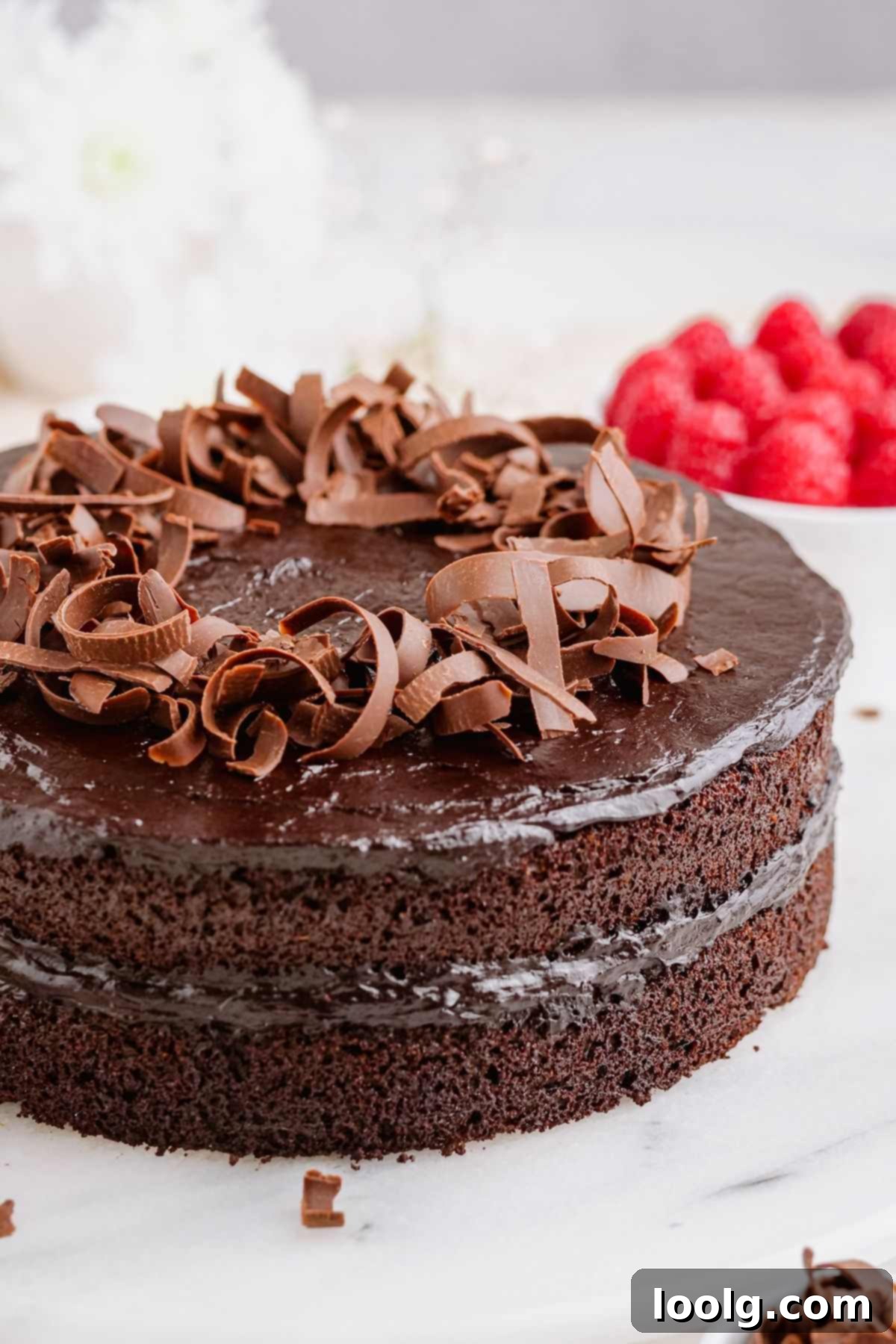
Choosing Your Perfect Frosting
A delicious cake deserves an equally delightful frosting, and this healthy chocolate cake is no exception. While the cake itself is moist and flavorful, the right frosting elevates it to an unforgettable dessert. Initially, this recipe featured a simpler cocoa, honey/maple syrup, coconut oil, and nut butter frosting, ideal for a 9″x13″ sheet cake. However, for a beautiful, stable layer cake, a different consistency is needed. Therefore, I’ve gathered several fantastic frosting options, each offering a unique flavor and texture profile to perfectly complement your healthy chocolate cake.
Chocolate Avocado Frosting: A Naturally Decadent Choice
The frosting you see generously coating the cake in the photos is my acclaimed Chocolate Avocado Frosting. This recipe is a game-changer for those seeking a healthier, dairy-free, and vegan option that doesn’t skimp on richness. Made with ripe avocados, cocoa powder, and natural sweeteners, it’s surprisingly rich and creamy, with absolutely no discernible avocado taste. It provides a beautiful, spreadable texture perfect for filling and frosting layer cakes. You’ll find the complete recipe details for this frosting alongside the cake recipe below. For more in-depth information, including detailed tips and substitution queries, be sure to check out the dedicated post on my other blog: Chocolate Avocado Frosting.
Healthier Cream Cheese Frosting: A Tangy Sweet Dream
If you enjoy the classic tang and sweetness of cream cheese frosting and don’t mind a touch of powdered sugar, my Healthier Cream Cheese Frosting is an absolutely amazing pairing for this chocolate cake. This recipe is specifically designed to be lighter than traditional versions while still offering that irresistible creamy texture and balanced flavor. The standard yield is ideal for filling the middle layer and applying a generous top layer, as demonstrated in the accompanying photos. If you desire to frost the sides of your cake as well, simply increase the quantities using these measurements:
- 16 ounces (450 grams) cream cheese, at room temperature
- 1/4 cup (56 grams) unsalted butter, at room temperature
- 1 1/3 cups (160 grams) powdered sugar, sifted to prevent lumps
- A pinch of salt to enhance flavors
- 1/2 teaspoon pure vanilla extract
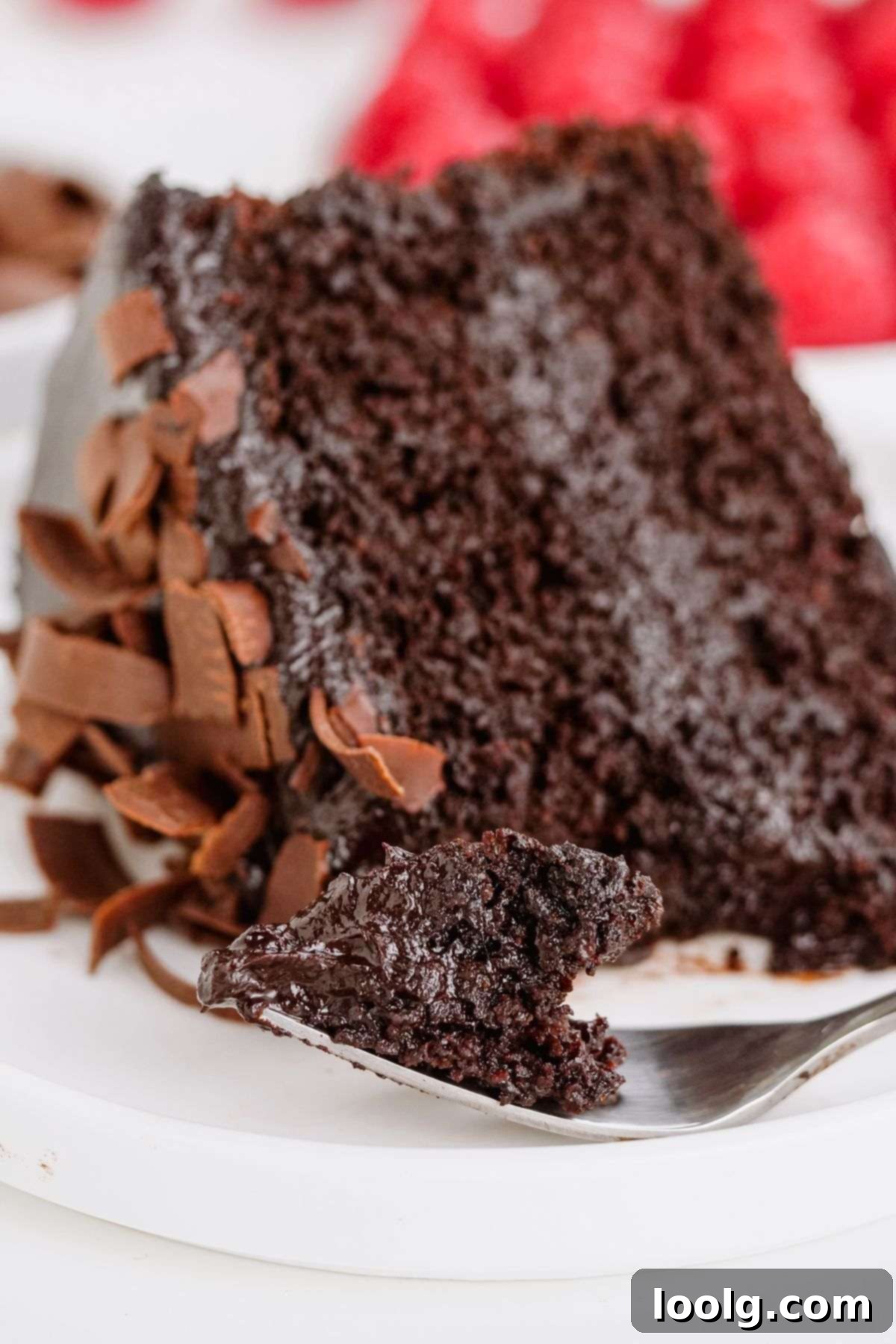
Paleo Vegan Chocolate Fudge Frosting: Rich and Luscious
For an intensely rich and utterly luscious experience, consider frosting this cake with my Paleo Vegan Chocolate Fudge Frosting. This option offers a deeply chocolatey flavor and a dense, fudgy texture that is truly indulgent. While it does use chocolate chips, meaning it’s not entirely refined sugar-free, it is still a significantly healthier alternative compared to many conventional fudge frosting recipes. To ensure you have enough to fill the middle and generously cover the top of your cake, I recommend doubling the recipe. If you wish to frost the sides as well, triple the recipe for ample coverage.
3-Ingredient Whipped Ganache: Effortless Elegance
For a remarkably simple yet elegant frosting, my Vegan Chocolate Frosting is an unbeatable choice. It requires just three ingredients: chocolate chips, full-fat canned coconut milk, and a touch of salt. This ganache-style frosting whips up easily, creating a light yet rich topping that is perfect for any chocolate cake. The recipe yields enough to beautifully frost the middle, top, and sides of a layer cake, providing a smooth, glossy finish that is both stunning and delicious.
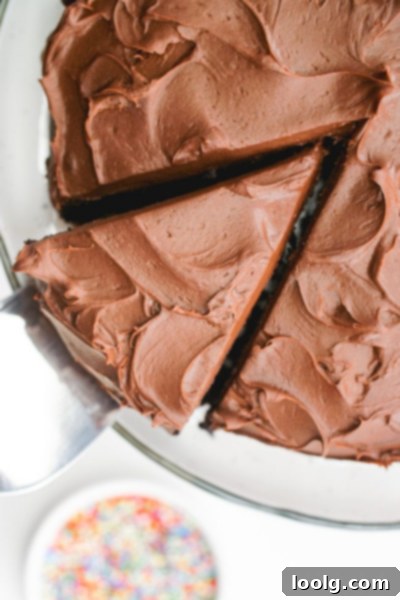
Creative Topping Ideas for Your Healthy Chocolate Cake
Once your healthy chocolate cake is frosted to perfection, the final touch is the topping. This is where you can truly let your creativity shine and add an extra layer of visual appeal and flavor. For a sophisticated and elegant presentation, I often opt for delicate chocolate curls, which instantly elevate the cake’s appearance. Beyond this classic choice, there’s a world of natural and vibrant toppings that can beautifully complement the rich chocolate flavor:
- Fresh Berries: A scattering of fresh raspberries, strawberries, or blueberries adds a burst of vibrant color and a delightful tartness that cuts through the richness of the chocolate. Their natural sweetness and juicy texture are always a crowd-plepleaser.
- Crushed Dried Raspberries: For a more intense berry flavor and a beautiful contrasting color, crushed dried raspberries provide a wonderful crunch and concentrated fruitiness.
- Naturally Colored Sprinkles: If you’re looking for a fun and festive touch, naturally colored sprinkles are a fantastic option. Brands like ColorKitchen Rainbow Sprinkles (made from nature) offer vibrant hues without artificial dyes. If you have any favorite brands available in your region, especially outside the US, I’d love to hear your recommendations!
- Chopped Nuts: Toasted chopped nuts such as pecans, walnuts, or almonds add a lovely textural contrast and a rich, earthy flavor that pairs wonderfully with chocolate.
- Coconut Flakes: Lightly toasted coconut flakes can provide a delicate crunch and a subtle tropical note, especially if you’ve used coconut sugar in the cake.
- Mint Leaves: A few fresh mint leaves can offer a refreshing aroma and a beautiful pop of green, particularly if serving with berries.
Mastering Piped Decorations
Should you wish to add a touch of artistry to your healthy chocolate cake with piped designs and decorative swirls, you’ll need to prepare a bit more frosting than usual. As a general rule, aim for approximately 1.5 times the standard frosting recipe. While you likely won’t use every last bit, having extra ensures you won’t run short in the middle of decorating, and any leftover frosting can be frozen without issue for future use.
For successful piping, the consistency of your frosting is key. It needs to be firm enough to hold its shape, so chilling your frosting sufficiently is a crucial step. Place it in the refrigerator until it reaches a firm, pipeable consistency. If you’re new to the world of frosting artistry and keen to hone your skills, I highly recommend exploring this comprehensive Piping 101 Manual. It offers invaluable guidance and tips to help you achieve beautiful and professional-looking piped decorations on your cakes.
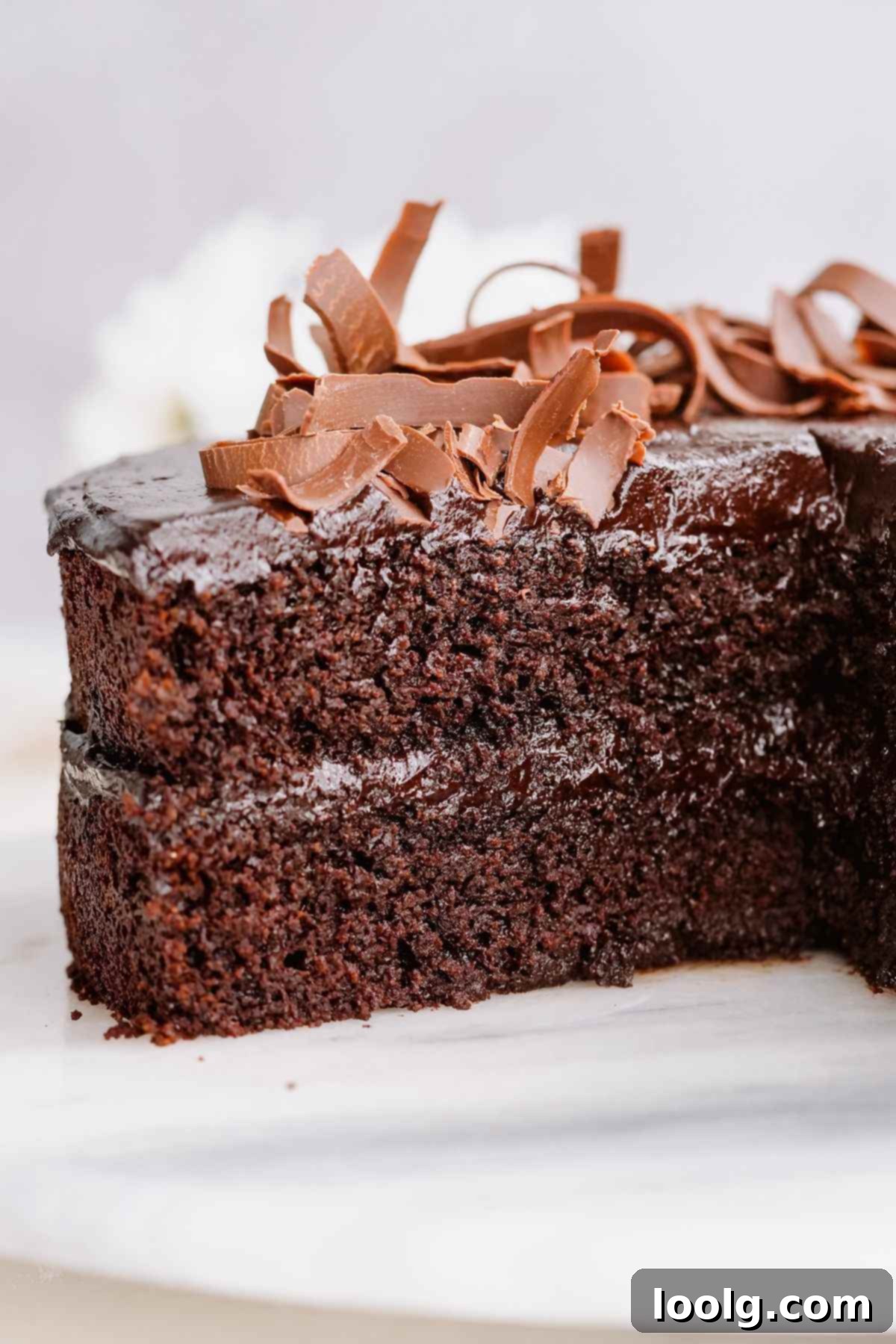
Frequently Asked Questions About This Healthy Chocolate Cake
Here are some common questions about making this versatile and delicious healthy chocolate cake:
Can I use a different egg replacer?
I’ve only rigorously tested chia eggs in this specific cake recipe, and I was genuinely surprised by how effectively they worked, providing excellent structure and moisture. Egg substitutes can be tricky in cakes, often leading to varied results. While it’s possible that other commercial egg replacers might work if you’ve had good success with them in similar cake recipes, I cannot guarantee the outcome as I haven’t personally tested them for this particular formulation.
Can I truly use any type of oil for the cake?
Yes, you can use any neutral-tasting liquid oil. Options like light olive oil, canola oil, vegetable oil, or grapeseed oil are all excellent choices. The key is “neutral-tasting.” If you opt for unrefined coconut oil, be aware that your cake might develop a subtle coconut flavor. However, refined coconut oil is completely neutral in taste, and if you choose this, make sure to melt it before incorporating it into the batter for smooth mixing. Using oil rather than butter is crucial for maximum moisture, as oil is 100% fat while butter contains water and milk solids.
If I use olive oil, will I taste it in the final cake?
This is a common concern! When using extra-virgin olive oil, you might detect its characteristic flavor in the raw batter and immediately after the cake emerges hot from the oven. However, once the cake has completely cooled to room temperature, the olive oil flavor typically dissipates entirely, leaving behind only the rich chocolate notes. I usually use an organic, mid-range extra-virgin olive oil from brands like Aldi or Lidl, not an overly expensive or intensely flavored one. If you’re particularly sensitive or worried about the taste, selecting a “light” olive oil (which refers to its milder flavor, not fewer calories) is a safe bet.
Can I use butter instead of oil?
While you probably *could* substitute butter for oil, it’s generally not recommended for this particular cake if you want to achieve maximum moisture. The reason lies in the fat content: oils are 100% fat, whereas butter is typically 80-82% fat, with the remainder being water and milk solids. This difference means oil contributes significantly more moisture to the cake, resulting in that wonderfully tender and rich crumb. For the best, most moist results, sticking to oil is the way to go.
Can I use different types of gluten-free flour, other than a 1:1 blend?
No, for this specific recipe, you cannot substitute flours like almond flour, coconut flour, oat flour, or other single-source gluten-free flours. This recipe is formulated to work with a 1:1 gluten-free baking mix, which is specifically designed to replace all-purpose flour in standard recipes without major adjustments to liquid ratios or leavening. Using alternative gluten-free flours would require significant modifications to the recipe’s chemistry and structure, likely leading to a very different (and potentially unsuccessful) outcome.
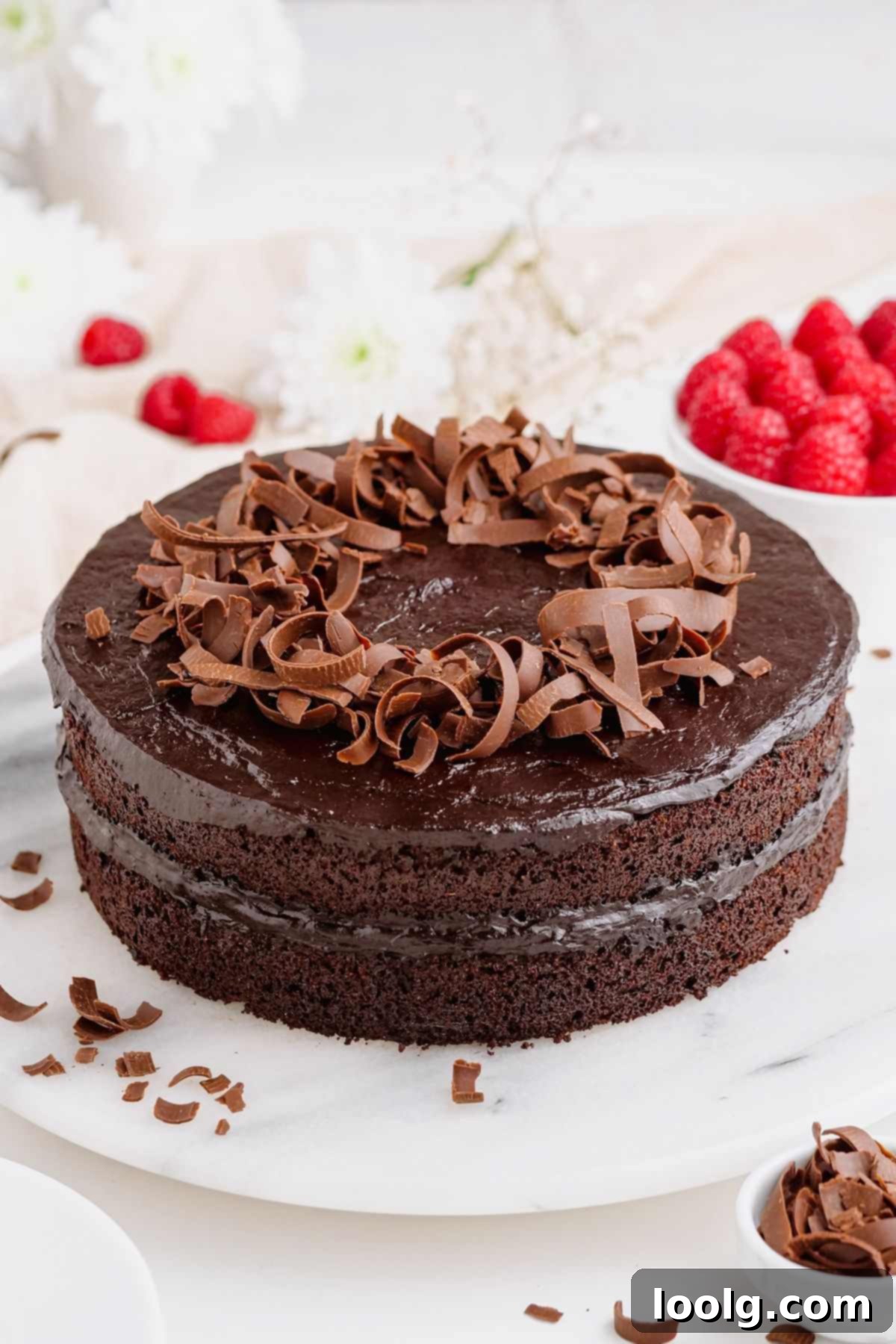
Does the gluten-free version taste “gluten-free”?
Absolutely not! This is one of the recipe’s proudest achievements. When made with a recommended 1:1 gluten-free flour mix (like Bob’s Red Mill or King Arthur’s), and once the cake has had a chance to cool completely, it tastes remarkably similar to a cake made with regular all-purpose flour. There’s no gritty texture or unusual aftertaste commonly associated with some gluten-free baked goods, making it a truly enjoyable option for everyone.
Does the whole wheat version taste like cardboard?
Rest assured, this whole wheat chocolate cake is anything but cardboardy! The generous amount of rich cocoa powder, coupled with the moistening effect of the oil and the sweetness from your chosen sugar, expertly masks any “wheaty” flavor that can sometimes be present in whole wheat baked goods. If you follow the recipe closely and use the recommended ingredients, you’ll be rewarded with a deeply flavorful and incredibly moist chocolate cake that tastes just as indulgent as one made with white flour.
Can I reduce the amount of sugar in the recipe?
Reducing sugar in baking can be tricky, as sugar plays a critical role not only in sweetness but also in moisture retention and cake structure. While you can make minor adjustments, don’t go overboard, as significant reductions can result in a drier, less tender cake. I believe reducing the sugar to 1 1/2 cups (from 2 cups) would likely be acceptable without drastically impacting the texture. However, I don’t recommend reducing it further than that for optimal results. If you’re using the honey version, it already has a naturally reduced sweetness (1 cup of honey instead of 2 cups of sugar), so I strongly advise against reducing the honey amount any further.
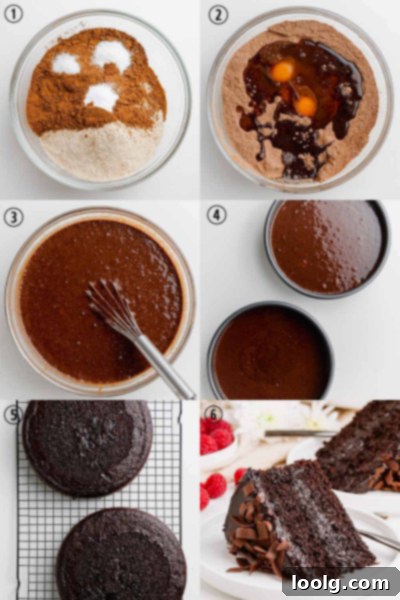
Can I use sweeteners other than those listed?
I have only personally tested this cake with honey, coconut sugar, and granulated sugar, and can confidently guarantee their success. If you prefer to use other sweeteners, you could experiment, but I can’t provide specific assurances. Generally, any liquid sweetener you’d typically substitute for honey (like maple syrup or agave nectar) would likely work, and similarly, any granulated sweetener you’d normally use in place of granulated sugar should also perform adequately. Should you try an alternative sweetener with great success, please let me know! Your feedback could help me add more suggestions for other bakers.
Can I freeze the cake layers or the entire frosted cake?
Absolutely! This cake is wonderfully freezer-friendly, making it perfect for preparing ahead or saving leftovers. Unfrosted cake layers offer great flexibility: they can be stored at room temperature for up to 2 days, refrigerated for up to 3 days, or frozen for up to 3 months. To freeze, simply allow the baked layers to cool completely, then wrap each layer individually and tightly in plastic wrap before placing them in a freezer-safe bag.
For convenience, you can assemble your cake with frozen layers directly from the freezer; they are actually easier to handle when firm. Once the cake is assembled and frosted, it can also be frozen for up to 3 months. For best protection, wrap the entire frosted cake securely in plastic wrap, then place it inside a larger freezer-safe container or bag. When you’re ready to enjoy, thaw the whole cake in the refrigerator overnight. Even a few hours in the fridge will typically suffice before serving.
With its perfect balance of rich chocolate flavor and an unbelievably moist texture, this healthy chocolate cake might just become your new go-to recipe. You may find yourself never baking a traditional chocolate cake again!
I genuinely hope you’ll enjoy baking and savoring this scrumptious cake. Should you decide to try it, I would absolutely love to hear about your experience! Please feel free to tag #easywholesome on social media so I can easily find and admire your beautiful pictures 📸. Happy baking!
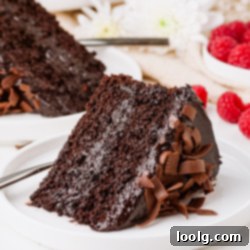
Healthy Chocolate Cake (whole wheat, gluten-free, vegan options)
Ingredients
Cake:
- 1 cup (320 grams) honey* or 2 cups (375 grams) coconut sugar or 2 cups (400 grams) granulated sugar
- 1 3/4 cups (210 grams) whole spelt flour, whole wheat flour, white whole wheat flour, all-purpose flour or 1 3/4 cups (236 grams) Bob’s Red Mill 1-to-1 gluten-free baking flour for a gluten-free version
- 3/4 cup (85 grams) cocoa powder (I prefer Dutch-process)
- 1 1/2 teaspoons baking powder
- 1 1/2 teaspoons baking soda
- 1 teaspoon salt
- 2 large eggs (50 grams each, out of shell) or 2 chia eggs** for vegan
- 1 cup (240 milliliters) milk of choice***
- 1/2 cup (120 milliliters) olive oil (or another neutral-tasting vegetable oil that’s liquid at room temp)
- 2 teaspoons vanilla extract
- 1 cup (240 milliliters) boiling water (this is not a typo!)
Frosting: (see post for different options)
- flesh of 1 avocado (155 grams)
- 1/2 cup + 2 tablespoons (72 grams) Dutch-process cocoa powder
- 1/2 cup + 2 tablespoons, maple syrup
- 1 teaspoon vanilla extract
- 1/4 teaspoon salt
- 2 tablespoons (28 grams) refined coconut oil
Instructions
-
If using honey, preheat your oven to 325 °F (167 °C). If not using honey (which bakes quicker than sugar, hence the lower temperature), preheat to 350 °F (175 °C).
-
Line 2 round 8″ cake pans with parchment paper on the bottom and then grease the sides of the pans.
-
In a large bowl, stir together the sugar (if using honey, don’t add it yet), flour, cocoa, baking powder, baking soda and salt.
-
Add eggs, milk, honey (if using), olive oil and vanilla. Mix for 2 minutes on medium and then stir in the boiling water. The batter will be almost as thin as water. If you taste it, it will NOT taste good! But don’t worry. It tastes great after baking.
-
Divide the batter between the two pans.
-
Bake for 25-30 minutes or until a toothpick comes out with some moist crumbs, but no uncooked liquid. The bake time will vary widely depending on what combination of sugar / eggs / flour you use. The whole wheat / egg / honey version is on the longer side. The gluten-free / chia egg / honey version is on the shorter side.
-
Let cool completely before frosting, about 1 hour. The unfrosted cake layers can remain at room temperature for up to 2 days, or they can be refrigerated for up to 3 days. Alternatively, you can freeze them for up to 3 months.
Chocolate Avocado Frosting:
-
Put all the ingredients (using 1/2 cup maple syrup) in a high-speed blender (or a small food processor) and blend until smooth. Taste and add up to another 2 tablespoons of maple syrup (I always do).
-
The frosting yields 2 cups + 1 tablespoon. That’s enough for a two-layer 8″ cake if you use about 3/4 cup to 1 cup for the middle and the other remaining cup on top.
-
The frosting will harden in the fridge but you can still cut it once it’s on the cake. It will be too firm to spread once cold, so just gently reheat it if you need to spread it after it’s been chilled.
-
It’s best used on the day of making but can also be stored for up to 2 days in the fridge. The longer it sits, the more avocady it gets (it doesn’t taste at all like avocado when you first make it). I only notice it after the first day.
How to store:
-
Cover and refrigerate the finished cake for up to 2 days (if you use a non-avocado based frosting, it’ll last another 3 days). It also freezes great for up to 3 months.
Video
Notes
** To make the chia eggs for this recipe, mix together 2 tablespoons of ground chia seed with 6 tablespoons of water until well combined. Let sit for about 1-2 minutes or until goopy like regular eggs.
*** You can use whatever type of milk you’d like. If you use canned coconut milk, water it down using 1/3 cup coconut milk and 2/3 cup water so that it’s runny like regular milk.
To make this cake vegan – use coconut sugar or granulated sugar (so – not honey!), dairy-free milk and the chia eggs option.
To make this cake dairy-free – use dairy-free milk.
To make it gluten-free – use the gluten-free flour listed.
Adapted from Hershey’s One Bowl Chocolate Cake.
The recipe below was the frosting recipe originally used for a 9″x13″ cake. It’s too runny for a layer cake. Use the chocolate avocado frosting recipe above, or see the post for several more options!
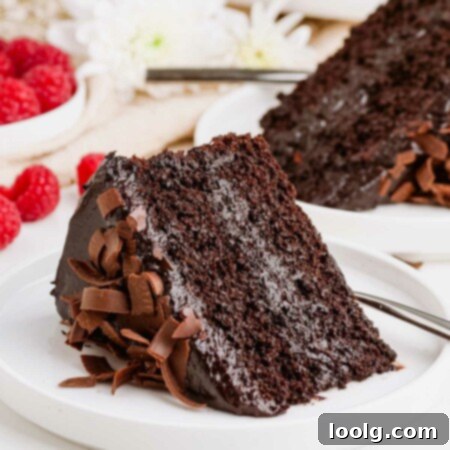
Chocolate Fudge Frosting
Ingredients
- 1/2 cup (113 grams) refined coconut oil*
- 1/2 cup (128 grams) natural peanut butter or another nut / seed butter (use the kind with just nuts / seeds and salt)
- 1/2 cup + 2 tablespoons (72 grams) cocoa powder
- 1 teaspoon vanilla extract
- salt to taste (be sure to add this! It really brings out the flavor)
- 1/3 cup + 2 teaspoons maple syrup
- if using sunflower seed butter: coconut sugar to taste (I used 5 teaspoons)
Instructions
-
Melt the coconut oil in a small pot or pan over low heat. Add the nut butter, cocoa powder, vanilla extract and salt and stir together. When it’s completely smooth, take it off the heat and add the maple syrup and stir until well combined.
-
If using sunflower seed butter, add coconut sugar to taste. Put the pot back on the burner and set to the lowest setting. Stir until the coconut sugar is dissolved.
-
If using another type of nut butter, you don’t need additional sugar. Let cool until room temperature and then spread over the cooled cake.
-
Store the frosted cake in the fridge for up to 5 days.
